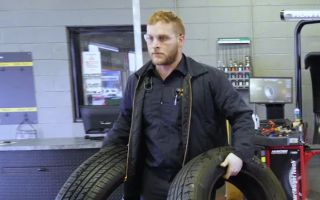How to Quickly and Safely Change a Tire When You’re in a Hurry
There’s nothing worse than being in a rush and suddenly realizing you have a flat tire. I’ve been there before—running late for an important meeting or appointment, only to find my car stranded with a punctured tire. In these moments, knowing how to change a tire efficiently can save time and frustration. Over the years, I’ve learned the fastest and safest way to replace a flat tire while ensuring I don’t make costly mistakes. This guide will walk you through exactly how I handle the situation when every second counts.

MR. TIRE INC.
2078 New York Ave, Huntington Station, NY 11746, USA
1. Ensuring Safety Before Starting
Even when I’m in a hurry, safety comes first. Changing a tire in an unsafe environment can lead to accidents or injuries. Here’s what I do to make sure I stay safe:

MR. TIRE INC.
2078 New York Ave, Huntington Station, NY 11746, USA
1.1 Pull Over to a Safe Location
If my tire goes flat while driving, I don’t stop immediately in the middle of the road. Instead, I look for a safe location, such as a parking lot or a wide shoulder away from traffic.
1.2 Turn On Hazard Lights
As soon as I stop, I turn on my hazard lights to alert other drivers that I’m dealing with an emergency. This is especially important at night or in bad weather.
1.3 Engage the Parking Brake
Before I start changing the tire, I engage the parking brake to prevent the car from rolling, especially if I’m on a slope.
1.4 Use Wheel Wedges
If available, I place wheel wedges (or bricks, rocks, or anything sturdy) behind the wheels to keep the car stable. This is especially helpful if I’m on uneven ground.
2. Gathering Tools Quickly
To save time, I make sure I have all the necessary tools before I start:
- Spare tire (properly inflated)
- Car jack
- Lug wrench (or impact wrench for speed)
- Wheel wedges (if available)
- Flashlight (if it’s dark)
- Gloves (optional, but useful for grip and cleanliness)
3. Removing the Flat Tire
3.1 Loosening the Lug Nuts Before Jacking Up
One mistake I made early on was trying to loosen lug nuts after raising the car. This made the tire spin, making it much harder to remove the nuts. Now, I always loosen them slightly before using the jack:
- I place the lug wrench on a nut and turn counterclockwise.
- If a nut is stuck, I use my foot to press down on the wrench for extra leverage.
- I loosen each lug nut but don’t remove them completely yet.
3.2 Positioning and Raising the Jack
Proper jack placement is crucial for safety. I always check the owner’s manual to locate the designated jacking point under the car. Here’s what I do:
- I position the jack under the car near the flat tire.
- I crank the jack until the car is lifted high enough to remove the flat tire.
3.3 Removing the Flat Tire
Once the car is raised, I fully unscrew the loosened lug nuts and carefully pull off the flat tire. I place it flat on the ground to prevent it from rolling away.
4. Installing the Spare Tire Quickly
4.1 Aligning and Mounting the Spare Tire
Since I’m in a hurry, I carefully align the holes in the spare tire with the lug bolt pattern before lifting it into place. I slide the spare onto the bolts and push it in as far as it will go.
4.2 Tightening the Lug Nuts by Hand
To keep the tire in position, I screw the lug nuts on by hand first. This ensures they are aligned properly before tightening them further.
4.3 Lowering the Car
Once the spare tire is in place, I slowly lower the car back to the ground by turning the jack in the opposite direction. After that, I remove the jack completely.
4.4 Fully Tightening the Lug Nuts
Now that the tire is on the ground, I tighten the lug nuts as much as possible using the lug wrench:
- I tighten them in a star pattern to evenly distribute the pressure.
- I double-check that all nuts are secure to avoid wobbling or uneven wear.
5. Checking and Cleaning Up
Before driving away, I always double-check a few things:
- I give the tire a quick shake to make sure it’s secure.
- I check the tire pressure if I have a gauge.
- I pack up all tools and put the flat tire in the trunk.
- I remove the wheel wedges if I used them.
6. When to Call for Roadside Assistance
Even though I know how to change a tire, there are situations where I call for help instead:
- Stuck Lug Nuts: If the lug nuts won’t budge, I don’t waste time struggling—I call a professional.
- Unsafe Location: If I’m on a busy highway or a dangerous area, I opt for roadside assistance instead of risking my safety.
- Damaged Spare Tire: If my spare tire is flat or missing, I know I’ll need a tow.
In emergencies, I trust Rescue & Towing for fast roadside assistance. Whether it’s changing a tire, jumpstarting a car, or towing to the nearest shop, their service is reliable and quick.
7. Final Thoughts
Changing a tire in a hurry doesn’t have to be stressful. With the right technique and preparation, I can get back on the road in under 15 minutes. However, if I ever feel unsafe or encounter issues beyond my control, I don’t hesitate to call Rescue & Towing for professional assistance.
























